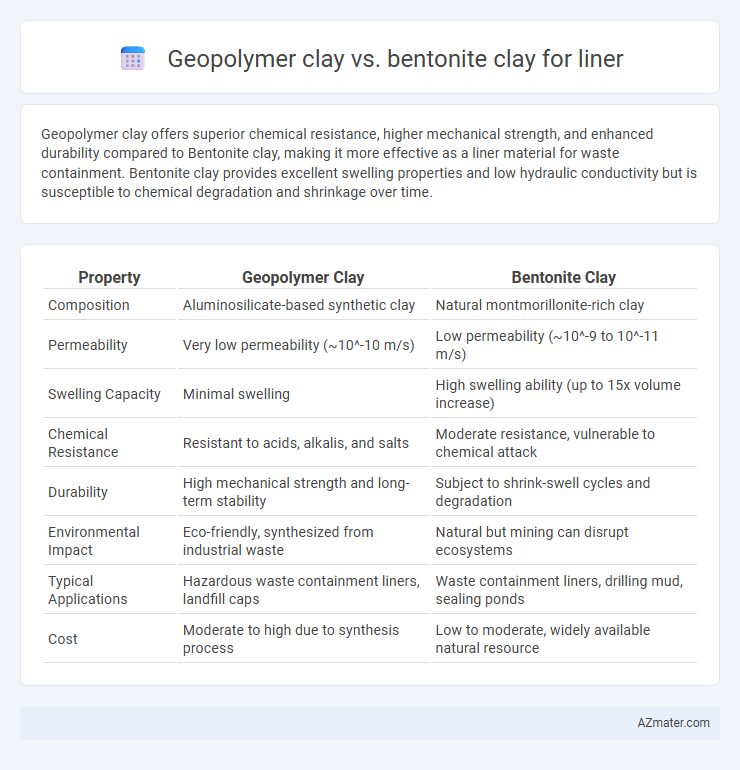Geopolymer clay offers superior chemical resistance, higher mechanical strength, and enhanced durability compared to Bentonite clay, making it more effective as a liner material for waste containment. Bentonite clay provides excellent swelling properties and low hydraulic conductivity but is susceptible to chemical degradation and shrinkage over time.
Table of Comparison
| Property | Geopolymer Clay | Bentonite Clay |
|---|---|---|
| Composition | Aluminosilicate-based synthetic clay | Natural montmorillonite-rich clay |
| Permeability | Very low permeability (~10^-10 m/s) | Low permeability (~10^-9 to 10^-11 m/s) |
| Swelling Capacity | Minimal swelling | High swelling ability (up to 15x volume increase) |
| Chemical Resistance | Resistant to acids, alkalis, and salts | Moderate resistance, vulnerable to chemical attack |
| Durability | High mechanical strength and long-term stability | Subject to shrink-swell cycles and degradation |
| Environmental Impact | Eco-friendly, synthesized from industrial waste | Natural but mining can disrupt ecosystems |
| Typical Applications | Hazardous waste containment liners, landfill caps | Waste containment liners, drilling mud, sealing ponds |
| Cost | Moderate to high due to synthesis process | Low to moderate, widely available natural resource |
Introduction to Clay Liners in Environmental Engineering
Clay liners in environmental engineering serve as crucial barriers for waste containment, preventing leachate migration into surrounding soil and groundwater. Geopolymer clay offers enhanced chemical resistance and mechanical strength due to its inorganic polymer matrix, while bentonite clay is prized for its high swelling capacity and low permeability, forming a tight seal. Selection between geopolymer and bentonite clays depends on site-specific conditions, including contaminant types, hydraulic conductivity requirements, and longevity of the liner system.
Overview of Geopolymer Clay: Properties and Composition
Geopolymer clay is an advanced material composed primarily of aluminosilicate minerals activated by alkaline solutions, resulting in a highly durable and chemically resistant liner. Its microstructure offers superior mechanical strength, low permeability, and excellent thermal stability compared to traditional bentonite clay liners, which rely on swelling properties for containment. The geopolymer's composition enables enhanced resistance to acidic and saline environments, making it ideal for long-term waste containment and environmental protection applications.
Bentonite Clay: Characteristics and Traditional Uses
Bentonite clay, composed primarily of montmorillonite, exhibits high swelling capacity and low permeability, making it ideal for lining applications in landfills and ponds. Its ability to form a watertight barrier prevents contamination and ensures effective containment of liquids and waste materials. Traditionally, Bentonite is valued for its natural adsorption properties and stability in geotechnical engineering projects.
Key Performance Criteria for Liner Materials
Geopolymer clay provides superior chemical resistance and mechanical strength compared to bentonite clay, making it highly effective for liners in hazardous waste containment. Bentonite clay excels in swelling capacity and hydraulic conductivity, offering excellent sealing properties but is susceptible to chemical degradation in acidic or saline environments. Key performance criteria for liner materials include permeability, durability, chemical stability, and shear strength, where geopolymer clay outperforms bentonite in long-term stability under extreme conditions.
Permeability and Hydraulic Conductivity Comparison
Geopolymer clay exhibits significantly lower permeability and hydraulic conductivity compared to bentonite clay, making it a more effective liner material for preventing fluid migration. Bentonite clay typically has hydraulic conductivity values ranging from 10^-9 to 10^-11 m/s, while geopolymer clay can achieve values as low as 10^-12 m/s due to its denser microstructure and enhanced chemical bonding. This superior impermeability enhances containment performance in waste management and environmental protection applications.
Chemical Resistance and Durability Evaluation
Geopolymer clay exhibits superior chemical resistance compared to bentonite clay, effectively resisting acidic and alkaline environments due to its stable aluminosilicate matrix. Durability evaluation shows geopolymer clay maintains structural integrity under aggressive chemical exposure, unlike bentonite clay which tends to swell and degrade over time in harsh conditions. These properties make geopolymer clay the preferred liner material for industrial waste containment requiring long-term chemical stability.
Mechanical Strength and Stability Analysis
Geopolymer clay exhibits superior mechanical strength compared to bentonite clay, with compressive strength values typically ranging from 10 to 40 MPa, whereas bentonite's strength is generally below 5 MPa, making geopolymer clay more suitable for high-load liner applications. Stability analysis demonstrates that geopolymer clay maintains structural integrity under varying pH and temperature conditions, while bentonite clay can experience swelling and shrinkage leading to potential liner failure. Both clays provide effective impermeability, but the enhanced mechanical durability of geopolymer clay offers improved long-term performance and reduced maintenance requirements in containment systems.
Installation and Constructability Factors
Geopolymer clay offers superior installation efficiency over bentonite clay due to its reduced curing time and enhanced workability, enabling faster liner deployment in containment projects. Unlike bentonite, which requires precise moisture content and compaction to achieve optimal swelling and sealing properties, geopolymer clay exhibits stable dimensional performance under varying site conditions, simplifying construction logistics. These factors collectively reduce labor intensity and installation risks, making geopolymer clay a more adaptable and reliable choice for liner applications in complex geotechnical environments.
Environmental Impact and Sustainability Assessment
Geopolymer clay liners offer a lower environmental footprint compared to bentonite clay due to their utilization of industrial by-products like fly ash, reducing the need for mining natural bentonite deposits. The synthesis of geopolymer clay requires less water and energy, minimizing greenhouse gas emissions during production, while bentonite extraction often leads to habitat disruption and increased carbon output. Sustainable assessment highlights geopolymer liners' enhanced durability and chemical resistance, which prolong landfill liner lifespan and reduce frequent replacements, supporting long-term ecological protection.
Cost Analysis and Economic Feasibility
Geopolymer clay offers a competitive advantage over bentonite clay in liner applications due to lower raw material costs and reduced processing energy requirements, contributing to overall cost savings. While bentonite clay is widely used for its superior swelling properties and permeability control, its price volatility and extensive mining impact increase long-term expenses. Economic feasibility studies show that geopolymer clay liners provide sustainable durability with potentially lower lifecycle costs, making them an increasingly attractive alternative in large-scale containment projects.

Infographic: Geopolymer clay vs Bentonite clay for Liner
 azmater.com
azmater.com